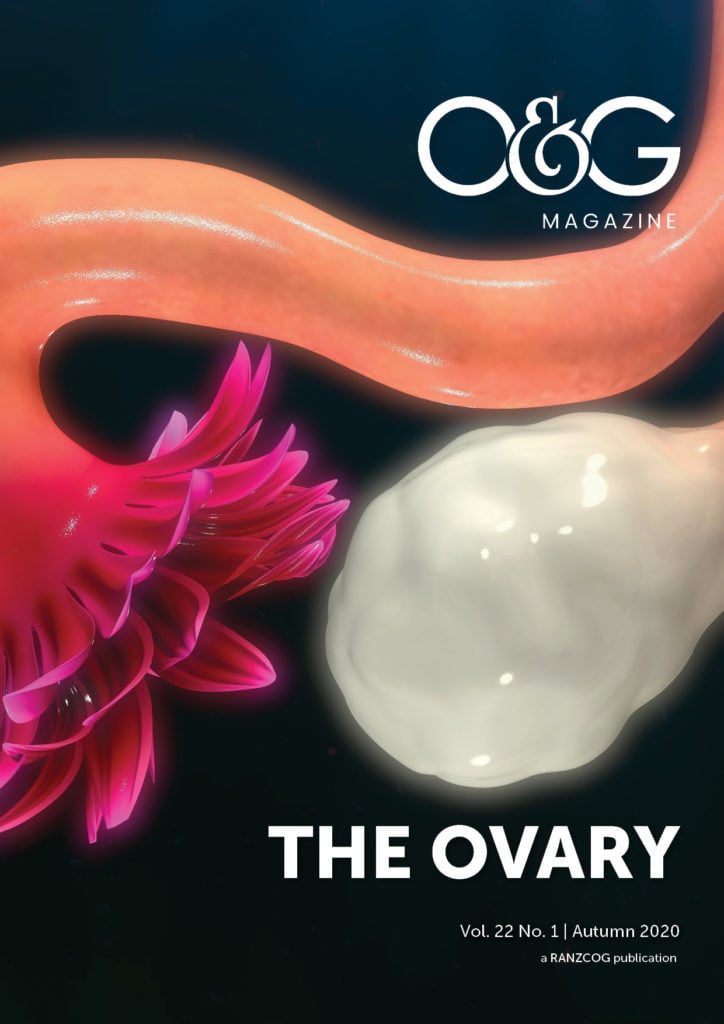Optimal ovulation is a sign of good health; not only of reproductive health but of all the body systems that contribute to reproductive function. Likewise, peak ovarian function contributes to optimal pregnancy outcomes.
A fully effective follicular and luteal phase relies on an intact hypothalamic-pituitary-ovarian axis which in turn acts on the endometrium, itself an endocrine-responsive organ. Under the influence of ovarian progesterone, the matured secretory endometrium allows for successful nidation of the blastocyst and placentation of the developing embryo.
Additionally, a complex interplay of many autocrine and paracrine factors (themselves mostly under the influence of pituitary or ovarian hormones) contribute to this highly refined implantation process1 and remain the focus of ongoing research in the area of infertility, pregnancy loss, recurrent miscarriage and pre-eclampsia.
Luteal phase physiology
In the pre-ovulatory dominant follicle, the granulosa cells become enlarged and vacuolated (under the influence of adequate FSH, aromatisation of androgens and resultant rising oestrogens) later to become the large cells of the corpus luteum.
At ovulation the theca lutein cells, previously surrounding the dominant follicle, migrate into the developing corpus luteum and become the small cells in the steroidogenesis of the luteal phase.
In this two-cell theory, LH, and subsequently HCG, act on the small cell receptors to signal the large cells (devoid of LH and HCG receptors) through gap junctions to produce the bulk of progesterone, oestradiol, inhibin-A and PGF2a.2
Therefore, the large (granulosa-lutein) cells respond to auto- and paracrine-acting peptides ensuring a basal level of progesterone and the small (theca-lutein) cells respond to central LH stimulation. This may account for the apparent stability and reproducibility of integrated progesterone serum profiles drawn in subsequent and more recent studies describing the luteal phase profile of hormones.3
Ovarian production of vascular endothelial growth factor (VEGF) allows for potent angiogenesis, neovascularisation of the corpus luteum and dissemination of ovarian hormones systemically.
Luteal phase defect
The existence of a luteal phase defect is reported extensively in the ART literature, thought to be due to the supraphysiological hormonal levels and their impact on LH secretion. As a consequence, luteal phase support is routinely provided, usually as progesterone therapy in early pregnancy; the dosage, duration and method continue to be researched.4
Despite being described in infertile women by Jones in 1949, there remains no clear diagnostic criteria or validated clinical solution.5 The only small RCT for progesterone support of the luteal phase in natural subfertile cycles was conducted in 1982.6 Lower integrated serum levels of luteal progesterone have been reported in young women establishing regular cycles, PCOS, stress cycles, athletes, and perimenopausal women, all of whom have higher rates of adverse early pregnancy outcomes.
The hypothesis that some subfertile women have pre-existing ovulatory and/or luteal phase dysfunction and may benefit from early pregnancy supplementation is the topic of some of this author’s randomised-controlled clinical trials.
Tubal transport
Tubal peristalsis and ciliary induced flow of secretory fluid and subsequent conceptus transport is dependent on ovarian progesterone, and prostaglandin F2a. Progestins, on the other hand, impair tubal transport. Ectopic pregnancies arise when embryonic transport is impaired by physical or hormonal factors.7
A recent case series was presented of 42 nulliparous women with a history of both miscarriage and ectopic pregnancy alone, of whom 28 underwent luteal hormone profiles. There was evidence of ovulatory dysfunction in 71.4% (n=20) of these women’s cycles.8
Implantation
Progesterone is the primary endocrine requirement for a mature secretory endometrium, which is rich in glycogen and lipids for initial diffusion to the developing embryo. Additionally, progesterone creates a balanced pro- and anti-inflammatory cytokine environment through progesterone-induced blocking factor (PIBF), it induces the formation of pinopodes aiding blastocyst attachment, and allows for IGF Binding Protein-1, which limits trophoblast invasion while simultaneously limiting endometrial growth.
Placentation
In early pregnancy, embryonic HCG and then maternal HCG ‘rescues’ the corpus luteum from its somewhat preprogramed demise. Along with local prostaglandin E2, HCG is luteotropic, allowing oestradiol and progesterone levels to rise above peak luteal levels further supporting the myriad of growth factors, cytokines and enzymes involved with trophoblast adhesion, invasion and limitation.
Placental hormonal shift
Progesterone is largely produced by the corpus luteum until about 10 weeks gestation. The placenta begins production at 7 weeks and continues to increase production surpassing the ongoing, but less significant, corpus luteal production. This shift is often seen as a slight initial fall in serum progesterone levels.
It is worth noting the location of the corpus luteum of any pregnant woman in her first trimester who may need laparoscopic surgery for a cyst accident, cystectomy, torsion or oopexy. Progesterone supplementation (100 mg daily as a minimum) should be given serious consideration if the ipsilateral ovary is impacted.
Miscarriage
Human experience and animal models show significant to universal miscarriage rates when the corpus luteum is surgically excised in early pregnancy, giving suboptimal progesterone levels.9 Low serum progesterone has been shown to be an independent risk factor for miscarriage in women with no obvious risk factors for pregnancy loss.10 A recent Cochrane review has found that giving progesterone supplementation early in a pregnancy of women with recurrent miscarriage of unknown aetiology may help.11
Threatened miscarriage
Women who experience a threatened miscarriage are at significantly increased risk of adverse pregnancy outcomes including antepartum haemorrhage, preterm delivery, perinatal mortality and low-birthweight babies. Whether hormonal support corrects these outcomes is unknown. A recent Cochrane review suggested progestogens are probably effective in the treatment of threatened miscarriage, but may have little or no effect on the rate of preterm birth.12 This review did not include a very large study13that found progesterone made no difference except, upon subgroup analysis, in those with a prior recurrent miscarriage history.
For future awareness
Recent research has shown that some endocrine-disrupting chemicals (EDCs) can impair key processes in ovarian development and disrupt steroid hormone levels in women.14 The EDCs with the most evidence are bisphenol-A (BPA), found in clear, tough plastics, and phthalates (plasticizers). Exposure to such exogenous compounds can mimic or antagonise ovarian function, particularly increasing follicular atresia/apoptosis and corpus luteolysis.
Additionally, BPA has been shown to attenuate steroidogenic gene expression in placental cells and decrease pregnancy progesterone levels.
Summary
Ovulation and continued corpus luteal function is critical for early pregnancy. The dominant luteal hormone, progesterone, orchestrates much of the early activity for the success of pregnancy. Luteal support by way of progesterone is required for ART pregnancies. Natural conception pregnancies may benefit from progesterone support, in some circumstances. Exposure to endocrine-disrupting chemicals may impact on ovarian function in the early pregnancy.
Further research needs to be given to inadequate function of the ovary at the crucial time point of early pregnancy and into the longer-term outcomes. Ovarian biology in early pregnancy is likely to have a role to play in the developmental origins of health and disease.
References
- Atwood CS, Vadakkadath Meethal S. The spatiotemporal hormonal orchestration of human folliculogenesis, early embryogenesis and blastocyst implantation. Mol Cell Endocrinol. 2016;430:33-48.
- Mesen TB, Young SL. Progesterone and the Luteal Phase: a requisite to reproduction. Obstet Gynecol Clin North Am. 2015;42(1):135-51.
- Messinis IE, Messini CI, et al. Luteal-phase endocrinology. Reprod Biomed Online. 2009 ;19(Suppl 4):4314.
- van der Linden M, Buckingham K, Farquhar C, et al. Luteal phase support for assisted reproduction cycles. Cochrane Database Syst Rev. 2015;7. CD009154.
- Schliep KC, et al. Luteal phase deficiency in regularly menstruating women: prevalence and overlap in identification based on clinical and biochemical diagnostic criteria. J Clin Endocrinol Metab. 2014;99(6):E1007-14.
- Balasch J, Vanrell JA, et al. Dehydrogesterone versus vaginal progesterone in the treatment of the endometrial luteal phase deficiency. Fertil Steril. 1982 ;37(6):751-4.
- Shaw JL, Dey SK, Critchley HO, Horne AW. Current knowledge of the aetiology of human tubal ectopic pregnancy. Hum Reprod Update. 2010;16(4):432-44.
- Hasted T, McLindon L. Previous miscarriage and ectopic pregnancy only – A case series supporting Luteal Phase Defect. Conference Poster. FSA Hobart, 2019.
- Csapo AI, Pulkkinen MO, Wiest WG. Effects of luteectomy and progesterone replacement therapy in early pregnant patients. Am J Obstet Gynecol. 1973;115(6):759-65.
- Arck PC, Rucke M, Rose M, et al. Early risk factors for miscarriage: a prospective cohort study in pregnant women. Reprod Biomed Online. 2008;17(1):101-13.
- Haas DM, Hathaway TJ, Ramsey PS. Progestogen for preventing miscarriage in women with recurrent miscarriage of unclear etiology. Cochrane Database Syst Rev. 2019;11. CD003511.
- Wahabi HA, Fayed AA, Esmaeil SA, Bahkali KH. Progestogen for treating threatened miscarriage. Cochrane Database Syst Rev. 2018;8. CD005943.
- Coomarasamy A, et al. A Randomized Trial of Progesterone in Women with Bleeding in Early Pregnancy. N Eng J Med. 2019;380(19):1815-24.
- Gore, AC, et al. Executive Summary to EDC-2: The Endocrine Society’s Second Scientific Statement on Endocrine-Disrupting Chemicals. Endocrine Reviews. 2015;36(6):593-602.





Leave a Reply